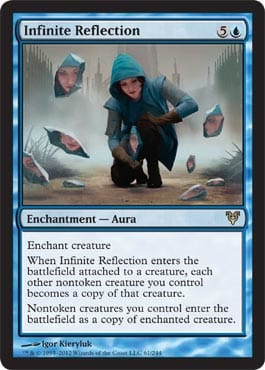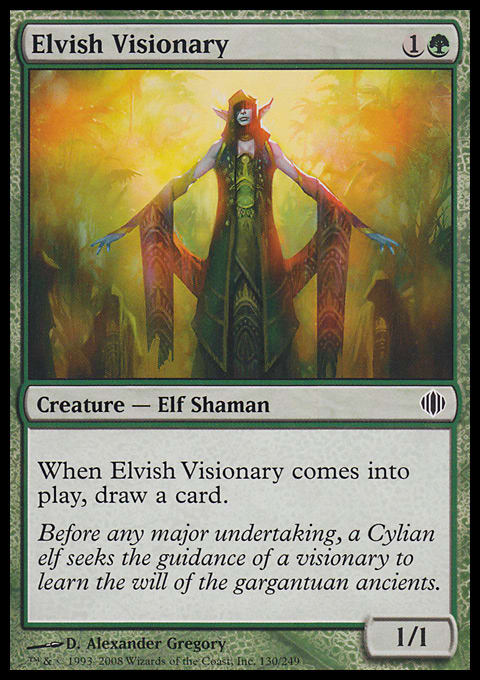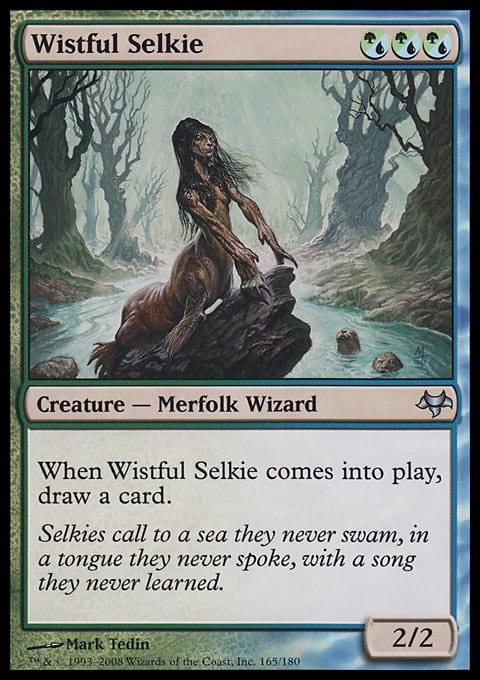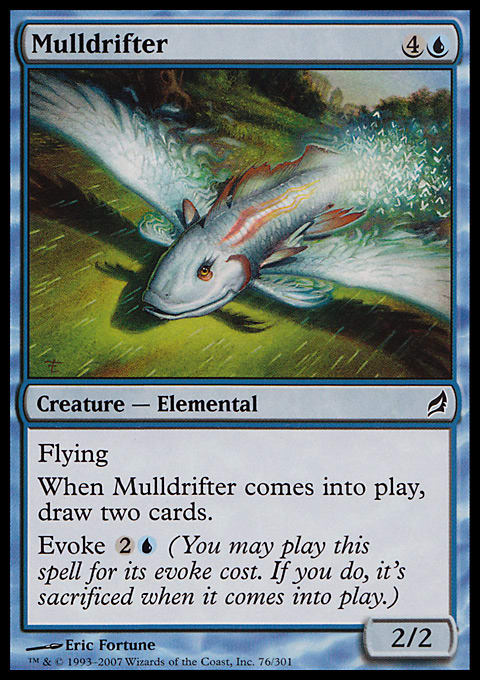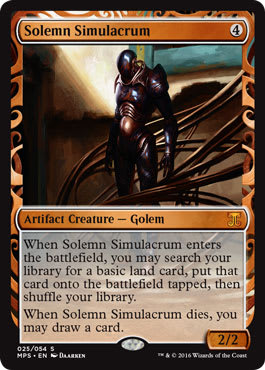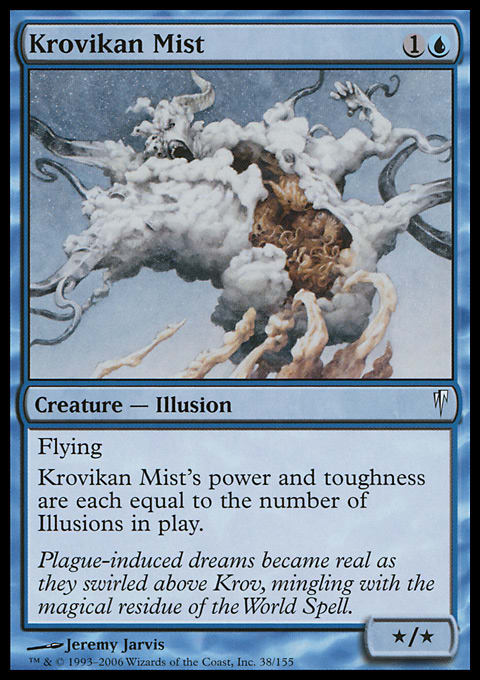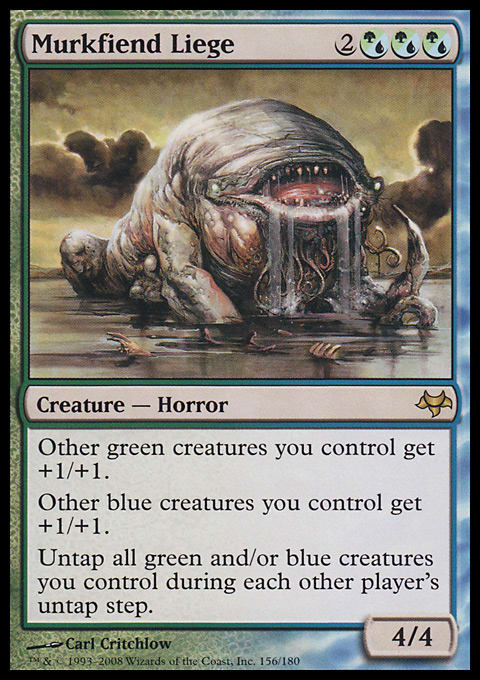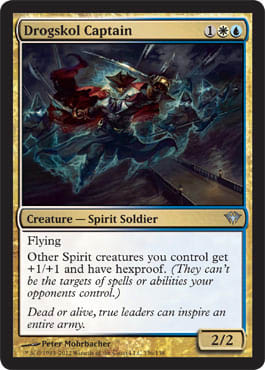In this experiment, we summon visionary and oracular creatures as we search our spellbook for an unending reflection of our horrific liege.
Infinite Reflection is a card that’s been around for a while now, and it offers a lot of potential. The problem is that it also gives us a series of hoops to jump through before it really does something profitable for us.
First, the temptation is to enchant a big, strong, expensive creature with Infinite Reflection. What’s the point using it at all if we’re not going to make our stuff big? Unfortunately, that often means the creature we want to enchant actually costs more than—or as much as—our 6-mana enchantment.
Second, Infinite Reflection comes with the usual invisible Aura drawbacks. Whenever we put an Aura on one of our own permanents, it comes with the risk that an opponent will respond by removing the target of the Aura—or do so shortly after. Now, a resolved Infinite Reflection can have a lasting impact on the board even if the creature it’s attached to is removed afterward, but that means it still has to at least resolve first.
And third, Infinite Reflection doesn’t do anything, even if it resolves, if we don’t have other creatures on the battlefield. And notably, those creatures can’t be tokens if we want the effect to benefit us. So, we need a creature to enchant to pump all of our other creatures, we need a bunch of other creatures to have the effect worthwhile in the first place, and we need to play a bit carefully to ensure our Infinite Reflection actually resolves on our preferred target. Let’s take a look at how we jump through a few of these hoops.
Enter the Battlefield, Draw a Card
When Infinite Reflection resolves, it replaces the properties of all our previously-resolved creatures. That means we can’t be too bummed out when our creatures lose their superpowers. Contrariwise, we want to be excited by resolving Infinite Reflection.
For example, if a creature has a death trigger, we’re put in an awkward situation: We want the creature to die (while trading for an opponent’s card) so we can benefit from the power, but we also want the creature to stick around so it can become a copy of our endgame creature, which then removes the creature’s death trigger.
Also, we want to play creatures quickly and often so that by the time we have Infinite Reflection ready, we have plenty of stuff on the battlefield. Normally, I’d be tempted to play token-producing spells because they can make multiple creatures for one card at a time; however, since Infinite Reflection doesn’t transform tokens, that’s just not an option. But there is another class of creatures that can act as multiple cards: those that replace themselves.
To start, Elvish Visionary is a creature that’s cheap and that immediately replaces itself when we play it. When we play it, we’re not down a card—in terms of cards, it’s a free 1/1, so we’ll still have cards left to put more bodies onto the field, and we’ll be digging through our library to find combo pieces at the same time. In addition, since its power will have already come and gone by the time we cast Infinite Reflection, we won’t be sad when Elvish Visionary becomes a copy of something else.
So that’s the game plan. If we can fill our deck with creatures that replace themselves, we can race through our deck while filling up the battlefield and finding the cards we need to turn the little, useless guys into an army of powerhouses.
Before we get to the powerhouse I selected, let’s take a look at the cantrip creatures.
Wall of Blossoms — This is historically among the best cantrip creatures. For only 2, we set up a strong early defense and draw a card.
Elvish Visionary — This is pretty useless as a 1/1, but it does its job of keeping our deck moving while sitting on the field, ready to transform.
Coiling Oracle — This Simic Snake is great—it doesn’t necessarily draw a card, but when it doesn’t, it tends to be even better for us. We can use this to accelerate into turn-three 4-mana spells or multiple 2-drops—all of which, of course, replace themselves as well.
Wistful Selkie — This one’s mana-intensiveness will be irrelevant for our G/U deck, and for 1 more mana over Elvish Visionary, we get +1/+1. It’s not a huge increase, but 2/2s will be able to trade off with more things than our 1/1s will when we need them to pre-Reflection.
Carven Caryatid — Here’s another defender cantrip with a little more oomph. Fortunately, turning these creatures into copies of something else later will take away their inability to attack.
Mulldrifter — And this one is pretty much the best option. Sure, we can just use it as a Divination when we really need to early, but that’s not really what we’re looking to do with it. We’d much rather have the three-for-one, and the lasting body is really what we’re looking for anyway. Gryff Vanguard is another option that didn’t quite make the cut for only drawing half as many cards.
Solemn Simulacrum — This guy is one that doesn’t really fit the theme here. It kind of has a Coiling Oracle ability of being able to put a land onto the battlefield tapped when it enters the battlefield, but we have to pay twice as much mana to do it. Also, the Simulacrum can never do an Elvish Visionary impression when it enters the battlefield. With all of our other creatures straight drawing cards, being a Rampant Growth instead is arguably better—our hand may be full of lands, but Solemn Simulacrum and Coiling Oracle are the only ones that gives us the potential to ramp. What normally makes the Simulacrum’s cost worthwhile is its death trigger, which draws us a card. As I went over earlier, however, we don’t really want our creatures to be dying early. It’s not always up to us, though, so when given the option of which of our creatures is sacrificed or has to chump-block or trade off with an attacker or whatever, we can choose Solemn Simulacrum and draw that extra card.
Pelakka Wurm — I wasn’t sure I actually wanted a cantrip creature that cost even more than Infinite Reflection, but I decided it was worth it to have an alternate beefy creature (we’ll cover the primary choice soon) and to just have something that can hold down the fort—or even steal the game—while still being on theme. And if we do use Infinite Reflection on Pelakka Wurm and then someone plays a Wrath of God effect, we should gain a good chunk of life. Also, I just like Pelakka Wurm.
Coat of Arms
When I realized the path I wanted to go down with Infinite Reflection, the first card that came to mind was Krovikan Mist. No, none of the cantrip creatures above are Illusions, so what’s the deal?
Basically, if we have, say, four creatures other than the Mist, when we put Infinite Reflection on it, all our five total creatures will be 5/5s with flying, letting us immediately attack for 25. That seems pretty strong.
What held me back from this plan was that Krovikan Mist is pretty terrible in our deck when it’s not reflected. In all other situations, it’ll be just a 1/1, and any opponent who knows what we’re up to will just kill it before we are able to untap with Infinite Reflection. We’d need 8 mana to cast the Mist and enchant it in a single turn, and while that could be pretty nice, that being our primary game plan makes our life much harder.
But after ruling out Krovikan Mist, I still had a good idea for what I was looking for. The next card that came to mind was Lord of Atlantis, but with no Merfolk either, that wasn’t an option. However, I knew the type of card I wanted, so the Gatherer search began. What I came up with was Murkfiend Liege.
The Seedborn Muse–style power is nice here, but it will basically just act as vigilance for us. But what we’re really excited about are the first two, very similar-looking, static abilities. The first power pumps up our green creatures: Elvish Visionary, Wall of Blossoms, Coiling Oracle, Wistful Selkie, Carven Caryatid, and Pelakka Wurm. And the second ability pumps up blue creatures: Coiling Oracle, Wistful Selkie, and Mulldrifter.
That’s a pretty strong board impact, making our Selkies formidable 4/4s and our Visionaries not-completely-embarrassing 1/1s. But where the abilities really shine is after Infinite Reflection.
Once that resolves, all of our creatures will be Murkfiend Lieges, which are both green and blue. So, as in the above example, when we had four creatures other than the reflected creature, we’d end up with a total of five Murkfiend Lieges. Since each Murkfiend Liege will give each other Murkfiend Liege +2/+2 (for being both green and blue), we’ll end up with a grand total of five 12/12s. We lose flying from the Krovikan Mist example, but our creatures are much, much larger.
And the best news is that Murkfiend Liege is just solid on the battlefield even when we don’t draw our Infinite Reflection. Also, at 5 mana, it slots into our curve just before the 6-mana Infinite Reflection.
Finally, I decided to throw in a Clone Legion. With all these creatures that draw cards and sit in play, it seems neat to just make a Clone of each of them, draw a bunch of cards, and generate an equivalent force of chump-blockers. Unfortunately, the Legion can’t become reflections, but that means they’re that much more eligible for other duties, such as attacking and blocking.
Murkfiend Reflection ? Casual | Andrew Wilson
- Creatures (34)
- 2 Pelakka Wurm
- 4 Carven Caryatid
- 4 Coiling Oracle
- 4 Elvish Visionary
- 4 Mulldrifter
- 4 Murkfiend Liege
- 4 Wall of Blossoms
- 4 Wistful Selkie
- 4 Solemn Simulacrum
- Spells (4)
- 1 Clone Legion
- 3 Infinite Reflection
- Lands (22)
- 4 Forest
- 4 Island
- 3 Lonely Sandbar
- 3 Tranquil Thicket
- 4 Temple of Mystery
- 4 Yavimaya Coast
Before I go, I want to share a couple other paths I could have traveled. Rather than, or in addition to, green, a couple other colors could stand in. Now, green offered the most cantrip creatures, so it’s hard to say we should cut it completely, but there are some more options, especially in white.
Wall of Omens, Messenger Falcons, and Rhox Meditant — Wall of Omens is fine in a W/U deck and replaces or supplements Wall of Blossoms in a very Planar Chaos fashion. Messenger Falcons can be played in a G/W deck or a W/U deck, and it would be right at home in a Bant deck. Rhox Meditant also wants us to be G/W, but we’ll need Infinite Reflection, thus making the Meditant another Bant option.
Thistledown Liege, Drogskol Captain, and Jelenn Sphinx — These are a few options for Infinite Reflection targets for a W/U or Bant list. Drogskol Captain offers the big benefit of having hexproof once Reflection has resolved on it (though it won’t have hexproof pre-Reflection since it only grants the ability to our other Spirits). Thistledown Liege has the advantage that we can cast it at the end of an opponent’s turn before untapping and dropping Infinite Reflection.
Phyrexian Rager and Baleful Strix — These are just a couple of cheap creatures that draw cards when they enter the battlefield. The Rager is decidedly less mana-intensive than Wistful Selkie for the slight disadvantage of costing us 1 life. Baleful Strix’s follow-up superpower is deathtouch, which seems much less exciting when we want to keep the creature on the battlefield; however, it can prevent foes from attacking us, as they’ll be too fearful of trading creatures, and that can work greatly in our favor.
Glen Elendra Liege and Diregraf Captain — Glen Elendra Liege gives us our flying back (from when we were going to have it with Krovikan Mist), which can be hugely beneficial when we just want to punch through and end the game. Diregraf Captain is cheaper and less mana-intensive, and it has deathtouch, which can stave off attackers while we set up, and it punishes an enemy extremely harshly if our board is destroyed (if all our creatures die, they’ll all trigger for each other, slicing away potentially huge chunks of life), but the pump bonuses will only be half as much as the Liege’s.
White and Black Infinite Reflection Options
- White (6)
- 1 Drogskol Captain
- 1 Jelenn Sphinx
- 1 Wall of Omens
- 1 Messenger Falcons
- 1 Rhox Meditant
- 1 Thistledown Liege
- Black (4)
- 1 Phyrexian Rager
- 1 Baleful Strix
- 1 Diregraf Captain
- 1 Glen Elendra Liege
If you love Elvish Visionary, if you want to double-pump with the G/U Eventide Horror, or if you need another chance to play with Infinite Reflection, give this deck a try.
Andrew Wilson
fissionessence at hotmail dot com













